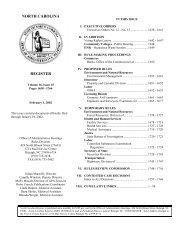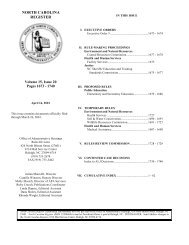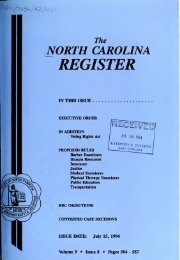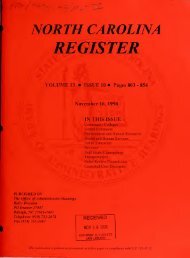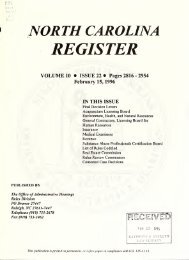NC Register Volume 9 Issue 15 - Office of Administrative Hearings
NC Register Volume 9 Issue 15 - Office of Administrative Hearings
NC Register Volume 9 Issue 15 - Office of Administrative Hearings
You also want an ePaper? Increase the reach of your titles
YUMPU automatically turns print PDFs into web optimized ePapers that Google loves.
.<br />
PROPOSED RULES<br />
—<br />
—<br />
—<br />
—<br />
adequate and practicable to protect<br />
the site; and<br />
(iii) the structure is limited in extent<br />
and scope to that necessary to<br />
protect the site;<br />
and<br />
(iv) any permit for a structure under<br />
this Part fM) £T) may be issued<br />
only to<br />
a sponsoring public agency<br />
for projects where the public<br />
benefits clearly outweigh the short<br />
or long range adverse impacts.<br />
Additionally, the permit must<br />
include conditions providing for<br />
mitigation or minimization by that<br />
agency <strong>of</strong> any significant and<br />
unavoidable adverse impacts on<br />
adjoining properties and on public<br />
access to and use <strong>of</strong> the beach<br />
(J) {N) Structures that would otherwise<br />
be prohibited by these standards may<br />
also be permitted on finding that:<br />
(i) the structure is necessary to maintain<br />
an existing commercial navigation<br />
channel <strong>of</strong> regional significance<br />
within federally<br />
limits; and<br />
authorized<br />
(ii) dredging alone is not practicable<br />
to maintain safe access to the<br />
affected channel; and<br />
(iii) the structure is limited in extent<br />
and scope to that necessary to<br />
maintain the channel; and<br />
(iv) the structure will not result in<br />
substantial adverse impacts to<br />
fisheries or other public trust<br />
resources; and<br />
(v) any permit for a structure under<br />
this Part {N) {J} may be issued<br />
only to<br />
a sponsoring public agency<br />
for projects where the public<br />
benefits clearly outweigh the short<br />
or long range adverse impacts.<br />
Additionally, the permit must<br />
include conditions providing for<br />
mitigation or minimization by that<br />
agency <strong>of</strong> any significant and<br />
unavoidable adverse impacts on<br />
adjoining properties and on public<br />
access to<br />
and use <strong>of</strong> the beach<br />
(K) Proposals for experimental erosion<br />
response measures will<br />
be considered<br />
on a case-bv-case basis to determine<br />
consistency with <strong>15</strong>A <strong>NC</strong>AC 7M<br />
.0200 and general and specific use<br />
standards within this Section.<br />
(2) Temporary Erosion Control Structures:<br />
(A)<br />
Permittable temporary erosion control<br />
structures shall be limited to sandbags<br />
placed above mean high water and<br />
parallel to the shore, include only the<br />
following;<br />
fi) Bulkheads or similar structures<br />
made <strong>of</strong> sandbags or comparable<br />
mate rials;<br />
(it) Low sandbag groins or sandbag<br />
sediment trapping structures above<br />
mean high water provided they<br />
are continuously buried by suit -<br />
able sand from an outside source.<br />
(B) Temporary erosion control structures<br />
{€)<br />
(©)<br />
{E)<br />
as defined in Subpart £2}(A) <strong>of</strong> this<br />
Paragraph may be used only to<br />
protect<br />
imminently threatened structures.<br />
Normally, a structure will be considered<br />
to be imminently threatened if its<br />
foundation septic system, or right-<strong>of</strong>way<br />
in the case <strong>of</strong> roads, is less than<br />
20 feet away from the erosion scarp.<br />
Shore parallel temporary erosion<br />
control structures— must not extend<br />
more than 20 foot past the end <strong>of</strong> the<br />
structure to be protected. The erosion<br />
control structure also must not come<br />
closer than <strong>15</strong> foot to tho applicant's<br />
side property linos unless the applica<br />
'<br />
tion is part <strong>of</strong> a joint project with<br />
neighbors trying to protect similarly<br />
threatened structures <strong>of</strong> unices the<br />
applicant has written permission from<br />
the affected property owner. The<br />
landward—side—e#—s«efl<br />
temporary<br />
erosion control structures shall not be<br />
located more than 20 feet<br />
the property to be protected.<br />
If a temporary erosion control<br />
seaward <strong>of</strong><br />
struc<br />
ture interferes with public access and<br />
use <strong>of</strong> the ocean beach, or if it re<br />
quires burial but remains continuously<br />
expo sed for more than six months it<br />
mu s t be removed by the permittee<br />
within 30 days <strong>of</strong> notification by the<br />
Coastal Resources Commission or its<br />
representatives.<br />
la<br />
addition,—the<br />
permittee shall be respon s ible for the<br />
removal <strong>of</strong> remnants <strong>of</strong> all or portions<br />
ef-—the temporary— erosion — control<br />
structure damaged by storm s<br />
or con<br />
tinuod erosion.<br />
Once the temporary erosion control<br />
structure is determined to be unnccos<br />
1187 NORTH CAROLINA REGISTER November 1, 1994 9:<strong>15</strong>




